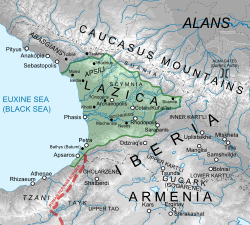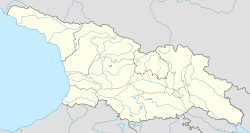User:PaulEverill2013/sandbox
Anglo-Georgian Expedition to Nokalakevi | |
|---|---|
 | |
| Coordinates: 42°21′00″N 42°11′00″E / 42.35000°N 42.18333°E | |
| Country | |
| Mkhare | Samegrelo-Zemo Svaneti |
| Time zone | UTC+4 (Georgian Time) |
| • Summer (DST) | UTC+5 |
The Anglo-Georgian Expedition to Nokalakevi , or AGEN (Georgian: ქართულ-ინგლისური ექსპედიცია ნოქალაქვში) has been excavating at the multi-period archaeological site of Nokalakevi since 2001. Nokalakevi was known as Archaeopolis, (Georgian: ნოქალაქევი, Greek Αρχαιόπολις) to early Byzantine historians, and Tsikhegoji (Georgian: ციხეგოჯი) to the neighbouring Georgian (Kartlian) chroniclers. Tsikhegoji translates as the 'fortress of Kuji' — a semi-mythical Colchian ruler or 'Eristavi', and supposed contemporary of Alexander the Great. The modern village and archaeological site of Nokalakevi is located in the Senaki municipality, Samegrelo-Zemo Svaneti region, Georgia.
Previous archaeological work at the site[edit]

Modern study of the site began shortly before the formal Russian annexation of Samegrelo, with a visit by the Swiss philologist Frédéric Dubois de Montpéreux in 1833-4. He identified the ruins as the Archaeopolis of Byzantine historians and argued that the site was Aia, the ancient Colchian capital of the Greek Argonaut myth.[1][2] This, unsurprisingly, stimulated much scholarly interest, which culminated in the 1920s with proposals for an archaeological excavation. In the winter of 1930-31, a joint German-Georgian team, led by Dr Alfonse-Maria Schneider of Freiburg University, traced the line of the walls and excavated about 40 survey trenches and one of the towers, as well as what they erroneously believed to be the agora in the 'lower' town. Their findings — including an impressive hoard of gold solidi of the Emperor Maurice (AD 584-602) — confirmed Dubois de Montpéreux's identification of the site with Archaeopolis, without settling the question of Aia.[3] Most scholars continued (and continue) to prefer the traditional identification of Aia with Kutaisi.

The political upheavals of the 1930s and the onset of war interrupted further archaeological excavation. Nevertheless interest in Georgia's history continued to grow, prompting various scholarly visits and articles about Nokalakevi from the 1930s [4] to the 1960s (see [2] for a discussion of previous work at Nokalakevi). Finally in 1973 a major state-sponsored expedition was set up, headed by the late Parmen Zakaraia. This expedition undertook major excavations and conservation work at Nokalakevi until the early 1990s when the collapse of the Soviet Union and the civil disturbances of Georgia's early years of independence brought a halt to funding and serious damage to the expedition's infrastructure [5][6][7][8]
Excavations from 1973 to 1991 had revealed substantial stone buildings of the fourth to sixth century AD. Beneath these early Byzantine period layers there was evidence of several earlier phases of occupation and abandonment, from the eighth to second centuries BC, including a very significant Hellenistic necropolis (4th-1st centuries BC) [9]
The Anglo-Georgian Expedition to Nokalakevi[edit]
AGEN was formed as a collaborative venture in 2000, following discussions between Professor David Lomitashvili, of the S. Janashia State History Museum (now the Georgian National Museum) and historian Ian Colvin of Cambridge University[10]. With the project directed by Lomitashvili and Colvin excavations were first resumed in 2001, with a small team of students from Cambridge University supervised by archaeologist Nick Armour. Following the success of the first season, the expedition was expanded in 2002, with a second trench opened and Paul Everill and Benjamin Neil joining the management team. Students from Cambridge participated again in 2002, but from 2003 to 2006 the student volunteers/ trainees came from Southampton. Bradford students formed the majority of the trainees in 2007, 2008 and 2011. A small team of students from Winchester participated in 2009 in the aftermath of the brief Georgian-Russian war of 2008, and 2010 saw a mixed team of students from Winchester, Bradford and Southampton[11] . In 2012, for the first time, the majority of the volunteers did not participate in the expedition as part of assessed fieldwork for a UK degree programme, though a number were drawn from Winchester University. Since 2012 the international volunteers/ trainees have come from a variety of countries and institutions.
Archaeology students from Georgian universities have participated since 2003 and it has become an important field school in modern methodology. Notable alumni of this school include Nikoloz Murghulia (now Deputy to Professor Lomitashvili) and Ana Tvaradze, both now employed by the Georgian National Museum. The methodology employed is British, though not Single context recording in its strictest sense as phase plans are utilised on occasion to show the relationship between multiple contemporary contexts. The application of this approach was based on the desire of the Georgian team to learn British methodological techniques, and there is now a small but burgeoning number of young Georgian archaeologists who are trained in them. The process of teaching Georgian students in the field in Nokalakevi is supported by placements with archaeological organisations. AGEN intends to continue to develop this training in the long term so that future threats to Georgian cultural heritage, posed by the increasing amount of development and infrastructure work in the country, will be dealt with by Georgian specialists armed with modern methodological techniques [12].
The Excavations (2001-present)[edit]
Working in two trenches, the deeply stratified deposits are revealing a long sequence of occupation, punctuated by episodes of abandonment and colluvial deposition. The lower town was the location of an early Hellenistic period settlement, consisting of rectangular clay and timber buildings with walls constructed on top of lines of limestone blocks. These stone wall bases sat directly on the ground surface, rather than within a foundation cut, and would therefore have provided an invaluable waterproof sill in the semi-tropical climate of Colchis. This settlement was later abandoned for a preferable location and the crumbling walls provided the setting for a necropolis. Burials from this period, of which 30 have been excavated in Trench A since 2001, vary in type from typical Hellenistic-style crouched burials adorned with copper alloy bracelets and glass beads; to inhumations contained within amphorae and dergi; and cremations. The south of Trench B has focused on the corner of a Christian cemetery, founded in the early Byzantine period and in use intermittently until the 19th century. Trench B which has produced 39, often intercut, Christian burials from a small area, demonstrating the longevity of its use from the early Byzantine period. The north of the trench has provided further information on the Hellenistic settlement. Ongoing excavation continues into pre-Hellenistic phases of occupation in both trenches[13].
The Staff[edit]
| Ian Colvin (University of Cambridge): Director, AGEN | Professor David Lomitashvili, Head of Georgian National Museum Expedition to Nokalakevi |
| Dr Paul Everill (University of Winchester): Co-Director, AGEN and Site Director | Dr Besik Lordkipanidze, Historian |
| Benjamin Neil (Bradford University): Co-Director, AGEN and Osteologist | Dr Nino Kebuladze, Head of Chemical Restoration (Georgian National Museum) |
| Kathy Grant (Archaeology South-East): Senior Supervisor/ Acting Site Director | Dr Nikoloz Murghulia, Deputy Head of Georgian National Museum Expedition to Nokalakevi |
| Laura James (Cambridge Archaeology Unit): Senior Supervisor, AGEN | Ana Tvaradze, Supervisor (Georgian National Museum) |
| Dr Jane Timby: Ceramics Specialist and Consultant to AGEN | |
| Antonio Reis (Archaeology South-East): Supervisor, AGEN | |
| Gemma Ward: Site Assistant, AGEN |
References[edit]
- ^ DUBOIS DE MONTPEREUX, F. 1839. Voyage du Caucase, volume 3 (Elibron facsimile 2005): 51-62. Paris
- ^ a b LOMOURI, N. 1981. Nokalakevis shestsavlis istoria, in Zakaraia, P. (ed.) Nokalakevi-Arkeopolisi : arkeologiuri gatxrebi I 1973-1977. Tbilisi
- ^ SCHNEIDER, A.-M. 1931. Archaeopolis (Nokalakewi), in Forschungen und Fortschritte 27, 20 Sept. 1931: 354-5
- ^ QAUKHCHISHVILI, S. 1936. Georgika: bizantieli mcerlebis cnobebi Sakartvelos šesaxeb; scriptorum byzantinorum excerpta ad Georgiam pertinentia. Tbilisi, Sakartvelos SSR mecnierebata akademiis gamomcemloba
- ^ ZAKARAIA, P. (ed.). 1981. Nokalakevi-Arkeopolisi: arkeologiuri gatxrebi I 1973-1977. Tbilisi
- ^ ZAKARAIA, P. (ed.) 1987. Nokalakevi-Arkeopolisi: arkeologiuri gatxrebi II 1978-1982. Tbilisi
- ^ ZAKARAIA, P. (ed.). 1993. Nokalakevi-Arkeopolisi: arkeologiuri gatxrebi III 1983-1989. Tbilisi
- ^ ZAKARAIA, P. & T. KAPANADZE. 1991. Cixegoji-Arkeopolisi-Nokalakevi xurotmozgvreba. Tbilisi
- ^ LOMITASHVILI, D. 1993. Stratigrafia nokalakevis nakalakarze (VII ubnis mixedvit), in Zakaraia, P. (ed.) Nokalakevi-Arkeopolisi : arkeologiuri gatxrebi III 1983-1989. Tbilisi
- ^ EVERILL, P., COLVIN, I., NEIL, B. and LOMITASHVILI, D. 2010. Nokalakevi-Archaeopolis: ten years of Anglo-Georgian collaboration. Antiquity 84 (326)
- ^ EVERILL, P., COLVIN, I., NEIL, B. and LOMITASHVILI, D. 2010. Nokalakevi-Archaeopolis: ten years of Anglo-Georgian collaboration. Antiquity 84 (326)
- ^ EVERILL, P., COLVIN, I., NEIL, B. and LOMITASHVILI, D. 2010. Nokalakevi-Archaeopolis: ten years of Anglo-Georgian collaboration. Antiquity 84 (326)
- ^ EVERILL, P., COLVIN, I., NEIL, B. and LOMITASHVILI, D. 2010. Nokalakevi-Archaeopolis: ten years of Anglo-Georgian collaboration. Antiquity 84 (326)
External links[edit]
Category:Archaeological sites in Georgia (country)
Category:Populated places in Samegrelo-Zemo Svaneti
Category:Museums in Georgia (country)
Category:Former cities in Georgia (country)
Category:Former populated places in the Caucasus


